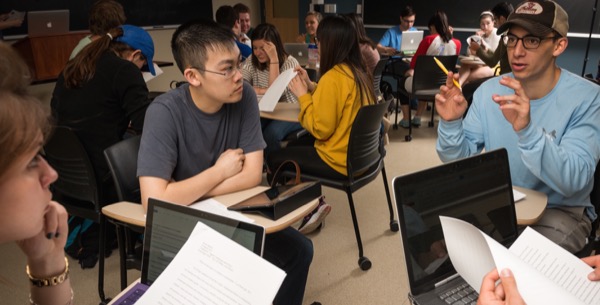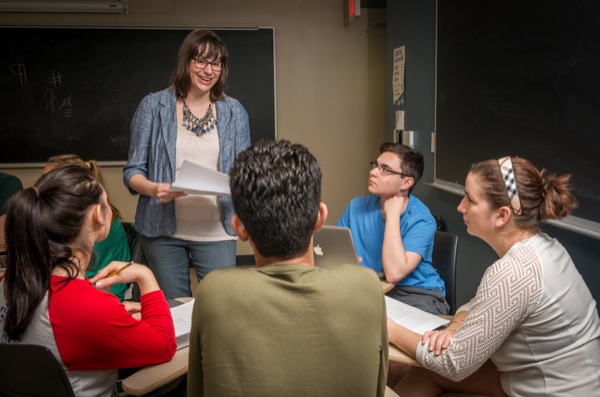


Practicing partnership
Students cross divides to apply technology to social, political problems
9:39 a.m., May 29, 2015--No one knows yet whether the brainstorms that emerged in Lindsay Hoffman’s experimental spring semester class, Digital Technology and Politics, will ever become must-have icons on a smartphone.
Good ideas emerged in that class, ideas that could amplify the voices of smart-but-lesser-known thinkers, give citizens a direct line to government officials, even help those with other things on their mind get up to speed on current events.
Campus Stories
From graduates, faculty
Doctoral hooding
But the class Hoffman convened in the University of Delaware’s Alison Hall had a bigger objective. While students were learning about the power and perils of technology in political contexts, they also would be crossing lines that had defined most of their studies to date.
Hoffman, associate professor of communication and political science, designed the course to include students from diverse disciplines and dozens enrolled – political science majors, communication majors, engineering majors.
They got loaner iPads for the semester, studied how technology factored into major political events around the world, then learned how to talk and work with students whose habits of mind were quite different in order to address some problem they agreed needed work.
Interdisciplinary work is central to the University's strategic plan and already proving itself in the marketplace through the efforts of programs such as the Office of Economic Innovation and Partnerships (OEIP), founded in 2008 under the direction of chemical physicist David Weir. Weir and Cyndi McLaughlin, assistant director, visited Hoffman's class to help students see the value of such crossover and develop new networks.
OEIP manages the University’s intellectual assets, works with small businesses in Delaware and helps enterprising students gain experience working with business leaders.
It also leads the Spin-In program that puts students with expertise in engineering and science together with majors in graphic design, public policy, communication and marketing to solve problems and create solutions for early-stage entrepreneurial companies.
The business owner gets tech-savvy recommendations and the students get experience in interdisciplinary collaboration and gain insight into how business plans and processes work in the real world of the entrepreneur. Four of those projects have gone to market, Weir said.
One student who participated in the Spin In program this year – producing a biofeedback device known as mTrigger for a medical equipment business – brought that experience to Hoffman’s class.
“From the beginning it was really weird integrating a lot of people,” Adam Engelson, an electrical engineering major, told his classmates early in the semester. “You have chemical engineers and political science majors and you learn how to work together. I learn social policy, you learn electronics. We learn to work together with a graphic designer, a chemical engineer and a business analyst, and you get exposed to the whole product life cycle.”
Those kinds of connections added energy to Hoffman's class and Courtney Griffin, a junior electrical engineering major, said it was clear that people with engineering backgrounds came at problems in much different ways than those studying politics or communication.
“A lot of our [engineering] classes are very structured and technically based, and they should be,” she said. “The interaction between different disciplines is sort of overlooked. This experience was very eye opening. And no one's opinion weighs more than anyone else's.”
Amanda Smith, a mass communication major with a minor in advertising, agreed.
“We think very creatively and they're very analytical,” she said. “It's hard to get your ideas across in ways they understand and vice versa.”
But, Smith and others agreed, that part of the challenge was fascinating and worthwhile.
“The thing most interesting to me is that trying to solve social problems is so ambiguous,” said Charlie Gleason, a junior electrical engineering major. “It's not something you traditionally do in engineering, where the problems are more concrete. So the way I have to present it has to be way more conceptual and less specific.”
Building these interdisciplinary bridges isn't easy or quick for students or faculty, Hoffman said.
“You need to be aware that it's going to be a big time commitment,” she said. “But it is hands-down the most rewarding class I've ever taught.... It's so enlightening to get outside of the academic silos we all find ourselves in.”
There's a reason those silos exist, of course. Budgets, staffing, materials and workflow all are built around specific college and department objectives. Discipline-based silos make work and communication easier, more predictable and easier to manage.
But they also make interdisciplinary work tough to develop. Each area has different requirements, for students and faculty. Faculty members have discipline-specific teaching and publishing to do. Students have course requirements to meet to earn their degrees. Changing those common lines can be tiring and frustrating, a heavy lift to add to already heavy-laden schedules.
There are few incentives to build new curricular paths, too, Hoffman said. To draw students to a 400-level course like this one – a course that is not required – and draw a co-teacher to a class outside of his or her required teaching load can be a tough sell.
She won't teach this class again until 2017, but Hoffman has been documenting her process and progress as a guide for like-minded faculty who want to build similar bridges.
Without a co-teacher, Hoffman brought in several guest authorities throughout the semester – computer science professor Lori Pollock, OEIP's Weir and McLaughlin, Ram Bala, a business owner, and a statistician, creative director, and COO of the regional venture capital firm Aspire Ventures – to give students a variety of perspectives on the process and the practicalities.
Weir listened as Hoffman’s students pitched their proposals. He pressed them to sharpen their ideas, clarify the distinctive quality of their applications and do their research on what it takes to make software succeed.
The world of business is a tough sell and he didn’t whitewash that. But learning to collaborate and see challenges from multiple perspectives gives students a competitive advantage, he said.
“This [class] is about interdisciplinary interaction – and that’s what the world out there is all about,” he told the students. “Universities train people to be in silos and then they go out and that’s not the way the world is. Providing this opportunity to students is a very important initiative.”
Russell Sonenclar, a senior communication major, said he had ideas he thought would be cool to have in an application, then learned from his engineering classmates whether such approaches were possible.
“They may say, ‘It's more realistic if we do this, this and this,’” he said. “And that's more parallel to the real world.”
Griffin said she sees software development in terms of how the computer will write it and how it will work, not in terms of marketing or design features. She considers the algorithms necessary and what kind of processing demands are involved.
“If you're delivering statistics, there is a lot of data on that server,” she said. “My job is to figure that out. The consumer wants to see that product. I have a better idea how the computer will see it, usually in terms of structure and coding and equations.”
Her teammates who specialize in marketing and communication and design could relate to consumer issues better.
Beyond the function, catchy logo and grand social strategy are other longer-term challenges, Pollock said, such as sustaining software after it is launched with fresh content and reliable user support.
In her years as a computer science professor, Pollock said she has seen plenty of ideas rise and fall and has seen the initial discomfort when different habits of mind collaborate.
“There are real stereotypes that come out, in just the way you might think they would,” she said. “You hear one group complaining about the other group. Then they figure out how to ease into it and things go better. It's not easy to do.”
But, Hoffman says, it is a worthwhile endeavor for students, faculty and the University.
“Technology is driving so much of our behavior, particularly when it comes to social and political issues,” she said. “It can either enable or disable. This is the kind of content we talk about. What are the problems that come up as technology becomes such an integrated part of our everyday lives and how does that impact society and democracy? But it can go beyond this; courses could be about creating an advertising campaign for sustainable fashion design and issues associated with women's studies – the combinations are infinite.
“Interdisciplinarity is such a buzzword for our research. It just makes total sense to do this in our teaching as well.”
Article by Beth Miller
Photos by Kathy F. Atkinson










